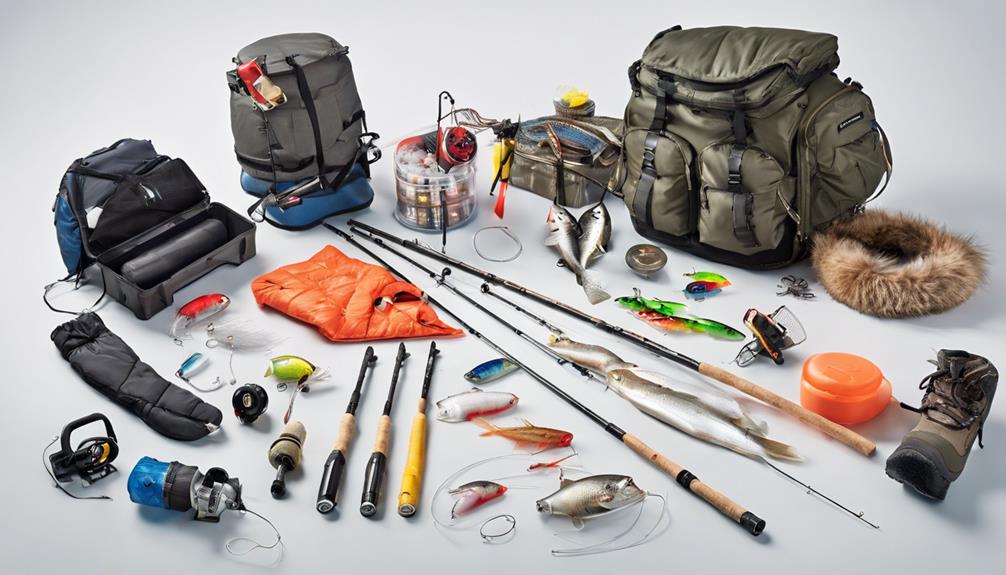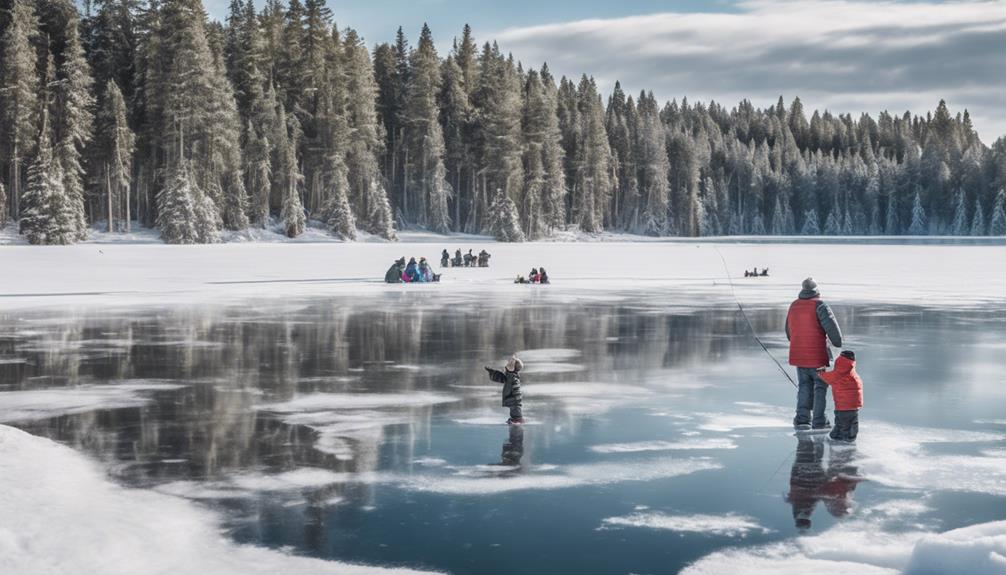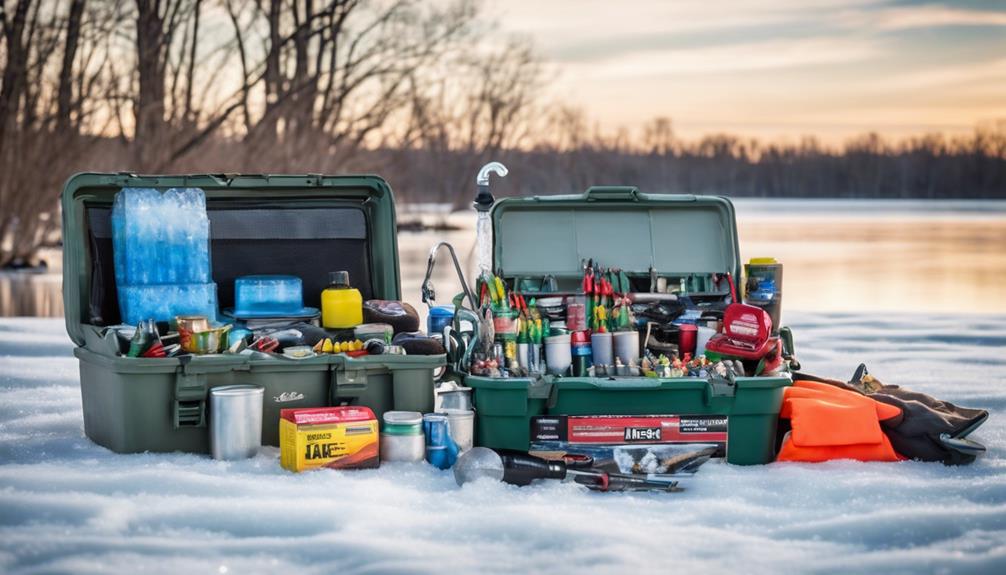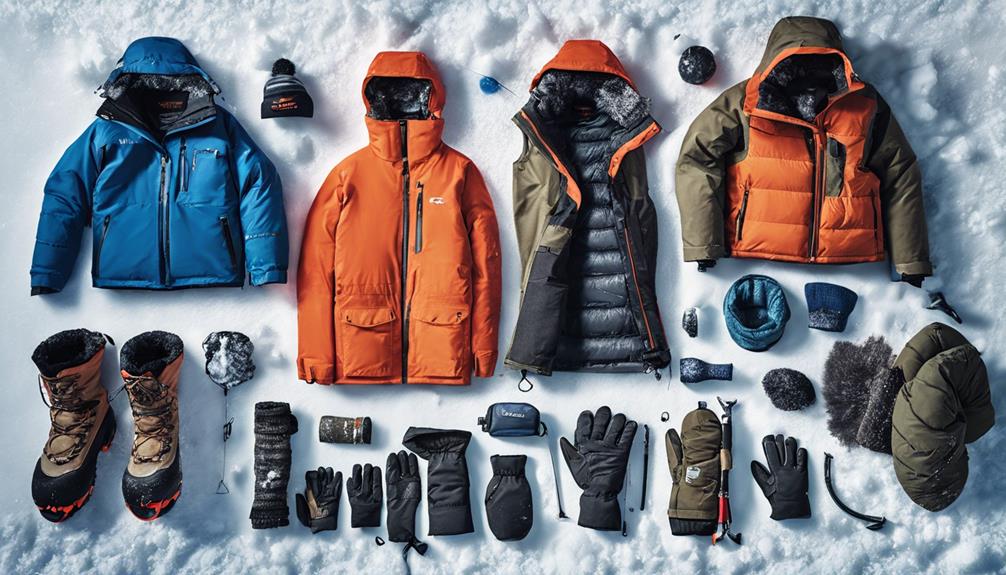When it comes to navigating the world of ice fishing gear, you might feel like a novice explorer in uncharted waters. But fear not, for equipping yourself with the right tools can make all the difference between a successful catch and a cold, uneventful day on the ice.
From specialized rods to essential accessories, each piece of equipment plays a crucial role in enhancing your ice fishing experience. So, let's break down the top gear that every novice angler should consider to elevate their ice fishing game.
Ice Fishing Rods
When selecting ice fishing rods, ensure they're sturdy and flexible for optimal performance on the frozen lake. Rod sensitivity is crucial when ice fishing, as you need to be able to feel even the slightest nibble from fish beneath the icy surface. A sensitive rod will transmit the movements of the fish up the line to your hand, alerting you to potential catches. Look for ice fishing rods that offer a good balance of sensitivity without being too delicate to handle the harsh winter conditions.
In terms of rod length, consider choosing a shorter rod for better control and maneuverability in the limited space of an ice fishing hole. Shorter rods, typically around 24 to 36 inches, allow you to easily jig your bait and set the hook without feeling cumbersome. Additionally, a shorter rod provides better leverage when battling larger fish through the ice. However, if you prefer fishing in deeper waters or want to achieve longer casting distances, opt for a slightly longer rod while still prioritizing sensitivity.
Ultimately, finding the right balance between rod sensitivity and length is key to a successful ice fishing experience. Experiment with different rod options to see what works best for you in various ice fishing conditions. Remember, the right ice fishing rod can make all the difference in landing that trophy fish through a hole in the ice.
Ice Fishing Reels
For optimal ice fishing performance, selecting a reliable ice fishing reel is essential. When choosing the right reel for your ice fishing adventures, there are key features to consider that will enhance your overall experience:
- Drag System and Line Capacity: A smooth drag system is crucial for controlling the tension on the line when battling with fish under the ice. Look for a reel with an adjustable drag system that can handle the weight of your target species. Additionally, ensure the reel has enough line capacity to accommodate the heavier lines often used in ice fishing to prevent line breakage.
- Gear Ratio and Ball Bearings: The gear ratio of an ice fishing reel indicates how many times the spool rotates with one turn of the handle. A higher gear ratio results in faster line retrieval, which can be advantageous when dealing with quick-swimming fish. Furthermore, the number of ball bearings in a reel affects its smoothness and durability. Opt for a reel with multiple ball bearings to ensure a silky operation even in cold temperatures.
Ice Fishing Line
Selecting the right ice fishing line is crucial for ensuring optimal performance and success on the ice. When choosing a line, consider factors such as line visibility and strength. Line visibility is essential in ice fishing, especially in the clear waters where fish can easily spot the line. Opt for a line color that blends well with the ice and snow to prevent spooking the fish. Fluorocarbon lines are popular for their low visibility underwater, while braided lines offer excellent strength for handling bigger catches.
In addition to visibility, the strength of the line is vital to withstand the harsh conditions and the potential strength of the fish you might hook. Make sure to select a line with the appropriate pound test rating based on the type of fish you're targeting. It's better to have a stronger line that can handle unexpected surprises than to risk losing a fish due to a line break.
When it comes to knot tying techniques, mastering a few reliable knots can make a significant difference in your ice fishing experience. The improved clinch knot and Palomar knot are commonly used and are known for their strength and reliability. Practice tying these knots before hitting the ice to ensure a secure connection between your line and lures. By paying attention to line visibility, strength, and mastering essential knot tying techniques, you'll be better equipped to tackle the challenges of ice fishing.
Ice Fishing Lures
Consider the variety of ice fishing lures available to enhance your chances of attracting fish in cold, icy waters. When it comes to ice fishing, choosing the right lure and using the appropriate techniques can make a significant difference in your success on the ice.
Top Ice Fishing Lures Recommendations:
- Lure Selection: Start with a selection of jigs in various sizes and colors to match the baitfish in the area you're fishing. Experiment with different shapes and weights to see what the fish are responding to.
- Techniques: Try jigging at different speeds and rhythms to find what entices the fish to strike. Vary your jigging motion from aggressive to subtle to trigger different feeding responses from the fish below.
- Ice Fishing Lure Customization: Consider customizing your lures with scents or adding bait to increase their attractiveness. Adding a piece of worm, maggot, or other live bait can sometimes be the extra incentive needed to tempt finicky fish.
Ice Fishing Shelter
Enhance your ice fishing experience by setting up a sturdy shelter to protect yourself from the elements and provide a comfortable base for your fishing adventures. When it comes to ice fishing shelters, portable warmth is key to staying cozy during long hours on the ice. There are various shelter options available to meet your needs and preferences.
One popular choice for ice fishing shelters is the portable ice fishing tent. These tents are easy to set up and provide excellent protection from the cold winds. They come in various sizes, so you can choose one that suits your group size and gear requirements. Portable ice fishing tents often feature insulated walls and floors, helping to trap heat inside and keep you warm.
Another option to consider is the flip-over ice shelter. These shelters are compact and easy to transport, making them ideal for solo anglers or those who prefer mobility. Flip-over shelters usually have built-in seats and storage compartments, offering convenience on the ice. They're designed for quick setup and takedown, allowing you to move swiftly between fishing spots.
For anglers looking for a more permanent solution, permanent ice fishing shelters are available. These sturdy structures can withstand harsh weather conditions and provide a comfortable fishing environment. While they require more effort to set up initially, they offer long-term durability and reliability for extended ice fishing seasons. Whether you opt for a portable tent, a flip-over shelter, or a permanent structure, having a shelter ensures you can enjoy ice fishing comfortably and safely.
Ice Fishing Auger
When drilling through the ice for fishing, having a reliable ice fishing auger is essential for easily creating holes. Here are three key points to keep in mind when using an ice fishing auger:
- Regular Auger Maintenance: Just like any other tool, your ice fishing auger requires proper maintenance to ensure it functions smoothly. Before each use, check the blades for sharpness and any signs of damage. Keep the blades clean and lubricated to prevent rusting. Additionally, store your auger properly in a dry place to avoid any corrosion.
- Practice Auger Safety: When using an ice fishing auger, safety should be your top priority. Always make sure to use the auger in an area where the ice is thick enough to support your weight. Wear protective gloves to avoid any injuries from sharp blades. Be cautious when drilling and keep bystanders at a safe distance to prevent accidents.
- Choosing the Right Auger Size: Selecting the correct size of the auger is crucial for your ice fishing experience. Smaller augers are lightweight and easier to transport, making them ideal for beginners. On the other hand, larger augers are better suited for drilling through thicker ice but can be more challenging to handle.
Ice Fishing Sled
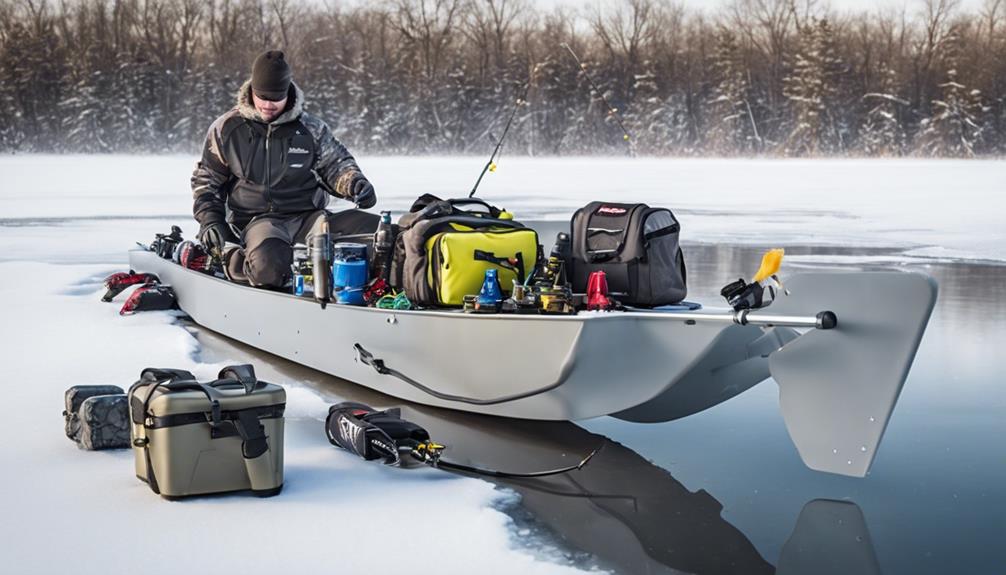
To haul your ice fishing gear effortlessly across frozen lakes, investing in a sturdy ice fishing sled is essential. When it comes to sled organization, look for a sled that offers compartments or storage pockets to keep your gear neatly arranged. This helps you access your equipment quickly without rummaging through a jumbled mess. Additionally, a sled with built-in rod holders or attachment points can prevent your fishing rods from getting tangled during transportation.
In terms of sled transportation, opt for a sled that's lightweight yet durable. This ensures that you can easily pull it across the ice without feeling weighed down. Many ice fishing sleds come with tow ropes or poles that make pulling them behind you a breeze. Consider the terrain you'll be traversing – if you anticipate rough ice or snow drifts, choose a sled with sturdy runners or skis for smoother mobility.
Efficient sled transportation also involves securing your gear properly. Use bungee cords or cargo nets to fasten down your equipment and prevent it from shifting during transit. This not only protects your gear but also maintains the sled's balance, making it easier to maneuver. By prioritizing sled organization and transportation, you can focus on enjoying your ice fishing experience without the hassle of lugging heavy gear across the frozen landscape.
Ice Fishing Accessories
What essential ice fishing accessories can elevate your angling experience on the frozen lakes? When heading out onto the ice, having the right gear can make all the difference. Here are three must-have accessories to ensure you have a successful and safe ice fishing trip:
- Ice Fishing Clothing: Staying warm and dry is crucial when spending hours out on the icy lake. Invest in quality insulated waterproof jackets and pants to protect yourself from the cold and wet conditions. Layering up with moisture-wicking base layers and thermal socks will help regulate your body temperature, keeping you comfortable throughout the day.
- Ice Fishing Safety Picks: Safety should always be a top priority when ice fishing. Ice safety picks are essential tools that can potentially save your life if you were to fall through the ice. These picks feature sharp metal spikes attached to a handle that you wear around your neck. In an emergency, you can use them to grip the ice and pull yourself out of the water.
- Ice Fishing Shelter: An ice fishing shelter provides protection from the elements, including wind and snow. Whether you opt for a portable pop-up tent or a more permanent ice house, having a shelter can make your fishing experience more enjoyable by providing a warm and comfortable space to relax between catches.
Frequently Asked Questions
How Do I Stay Warm While Ice Fishing?
To stay warm while ice fishing, layer up with thermal clothing and use hand warmers in your gloves and boots. Consider setting up an insulated shelter to block the wind.
Don't forget to bring hot beverages to keep you warm from the inside out. By following these tips, you can enjoy your ice fishing experience without getting too cold.
What Safety Precautions Should I Take While Ice Fishing?
When ice fishing, remember to prioritize safety. Always check the ice thickness before venturing out. Carry emergency response items like a whistle, ice picks, and a rope. Dress warmly and in layers.
Avoid going alone and inform someone of your plans. Stay away from areas with flowing water or thin ice. Being prepared and cautious will ensure a safe and enjoyable ice fishing experience.
How Do I Locate the Best Spots for Ice Fishing?
When looking for the best spots for ice fishing, start by scouting ice hole locations that show signs of fish activity, like underwater structures. Use sonar or fish finders to help locate potential hotspots.
To attract fish, consider using ideal bait options such as waxworms, minnows, or artificial jigs. Experiment with different depths and locations until you find where the fish are biting.
What Are Some Common Mistakes to Avoid While Ice Fishing?
When you're ice fishing, avoid common mistakes like neglecting equipment maintenance and wearing improper clothing. Keeping your gear in good shape ensures it functions properly when you need it most.
Make sure to dress in layers and wear waterproof clothing to stay warm and dry. By taking care of your equipment and dressing appropriately, you can have a more enjoyable and successful ice fishing experience.
What Are Some Tips for Catching More Fish While Ice Fishing?
To catch more fish while ice fishing, focus on bait selection and keeping your ice hole clear. Choose bait that suits the fish you're targeting and adjust if necessary.
Keep your ice hole free of debris and regularly check it to prevent refreezing. By staying on top of these key factors, you'll increase your chances of a successful day on the ice.
Conclusion
Now that you have all the right gear for ice fishing, you're ready to hit the frozen waters and start reeling in some fish.
Remember to stay safe, dress warmly, and have fun out on the ice. With the right equipment and a little patience, you'll soon be enjoying the thrill of ice fishing just like a pro.
So grab your gear, head out to your favorite spot, and make some unforgettable memories on the ice. Happy fishing!
